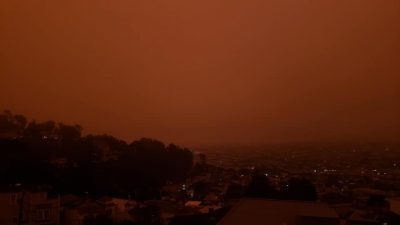California’s Burning. What’s the Link to Climate Change?
Answering your denialist friends

It’s a hard day to work in California, what with all the burning. Those closest to the fires and smoke are evacuating (or being rescued), or are among the brave men and women fighting in inferno-like conditions to increase fire containment. But even those of us far away and physically safe from the fires are distracted and scared. The skies won’t let us forget what’s happening all around. We’re posting photos, checking air quality monitors, texting friends, and looking out our windows. Just today, I’ve heard comparisons to the landscape of Venus; to the skies of Tatooine; to 9/11. (I’m relatively lucky in LA, compared to my Bay Area and NorCal colleagues; but even from my house, the nighttime moon has looked deeply orange and the daytime skies are a ghostly pink caramel.)
We’re posting to social media, too, in part to document for ourselves and posterity the extraordinary things we’re seeing, and in part to get the rest of country to understand, just a little, what it’s like here right now. Inevitably, we’re being questioned about the link between California fire risks and climate change. That link is well established: Climate change is making California fires worse, and it will continue to do so. It’s not the only factor relevant to fire risk today (fire management practices and housing patterns also contribute, among others), but it’s an important one that we ignore–or deny–at our literal peril.
What’s some of the best recent evidence of this link? I was glad to hear from a colleague at UCLA, the climate scientist Daniel Swain, about what he considers to be some of the best recent research and writing on this question. (If you’re not following Daniel on Twitter, at @Weather_West, you should be. His photos and analyses are extraordinary.) I’m sharing some of the resources he pointed me to, in case these are helpful to you as well.
Be safe out there, everyone.
-
Climate change is increasing the likelihood of extreme autumn wildfire conditions across California, in Environmental Research Letters (“[T]his analysis offers strong evidence for a human fingerprint on the observed increase in meteorological preconditions necessary for extreme wildfires in California. Absent a strong decrease in autumn wind patterns, observed and projected temperature and precipitation trends portend increasing risk that autumn offshore wind events will coincide with critically dry fuels—increasing the potential for wildfire catastrophes when fires affect populated areas.”)
-
Observed Impacts of Anthropogenic Climate Change on Wildfire in California, in AGU’s Earth’s Future (“Human‐caused warming has already significantly enhanced wildfire activity in California, particularly in the forests of the Sierra Nevada and North Coast, and will likely continue to do so in the coming decades.”)
-
Impact of anthropogenic climate change on wildfire across western US forests, in Proceedings of the National Academy of Sciences (“human-caused climate change caused over half of the documented increases in fuel aridity since the 1970s and doubled the cumulative forest fire area since 1984. This analysis suggests that anthropogenic climate change will continue to chronically enhance the potential for western US forest fire activity while fuels are not limiting.”)
- The Era of Megafires: The Crisis Facing California and What Will Happen Next, in The Guardian, coauthored by Drs. Daniel Swain, Crystal Kolden, and John Abatzoglou (written two years ago, this piece acknowledges several factors that combine to worsen California’s wildfires, and calls climate change a “wildfire threat multiplier”)
-
California and Colorado Fires May Be Part of a Climate-Driven Transformation of Wildfires Around the Globe, in Inside Climate News







Reader Comments